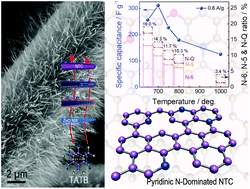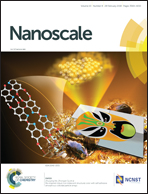Pyridinic-nitrogen highly doped nanotubular carbon arrays grown on a carbon cloth for high-performance and flexible supercapacitors†
Abstract
Pyridinic-nitrogen highly doped nanotubular carbon (NTC) arrays with multimodal pores in the wall were synthesized via a one-step template strategy using 1,3,5-triamino-2,4,6-trinitrobenzene (TATB) as both carbon and nitrogen precursors and ZnO nanowire (ZnO NW) arrays grown on carbon clothes as templates for high-performance supercapacitors (SCs). A strikingly high N-doping level of 14.3% and pyridine N (N-6) dominance as high as 69.1% of the total N content were achieved. Both the N content and N configuration can be well tailored by adjusting the carbonization temperatures of TATB. When directly applied as flexible SCs, the N-doped NTC yields a high specific capacitance of 310.7 F g−1 (0.8 A g−1), a cycling retention ratio of 105.1% after 20 000 charge–discharge cycles, and excellent capacitance retention rates of 93.6%, 74.2%, and 53.6% at 8 A g−1, 40 A g−1, and 80 A g−1, respectively, as compared to the value at 0.8 g−1. TATB, as the only precursor of C and N, is expected to be of great significance for the further design and synthesis of N-doped sp2 carbon nanostructures with selective N configurations and controlled N content.



 Please wait while we load your content...
Please wait while we load your content...